
Waves_in_Metamaterials
.pdf
Plasmon–polaritons |
3 |
|
|
|
|
3.1Introduction
Plasmas is an old and respectable subject. It was started by Langmuir1 in the 1920s. Its properties have been studied ever since but not always with the same vigour. Topics rose in response to new applications, and declined on reaching saturation or realizing that the chances of the envisaged solution are fast receding. The development of radio broadcasting led to the discovery of the Earth’s ionosphere that reflects radio waves and is responsible for reception of radio signals when the transmitter is over the horizon. Hannes Alfven’s theory of magnetohydrodynamics (1940) that treated plasma as a conducting fluid has been employed to investigate sunspots, solar flares, the solar wind, star formation and other topics in astrophysics. The interest in thermonuclear fusion came in the wake of the hydrogen bomb. At one time it was believed that fusion, assisted by plasmas, is round the corner. The belief turned out to be not well founded. Later, the invention of lasers opened the new chapter of laser plasma physics with some promise of fusion but that has not been realized either. High-energy physicists hope to use plasma acceleration techniques to dramatically reduce the size and cost of particle accelerators. Among the applications that have come o are microscopy and sensing (see, e.g., Yeatman 1996; Homola 2003; Barnes 2006).
We have enumerated only a fraction of plasma phenomena that could be discussed. The subject is not only old and respectable: it is also very big. Our interest is limited to plasmas on surfaces, the kind that was presented very briefly in Section 1.10. They are important for metamaterial applications that belong to two categories. One is their role in the subwavelength manipulation of images. If μr = 1 and εr = −1 then the plasma resonances will limit the range of spatial frequencies for which the transfer function is approximately flat. This was already briefly discussed in Section 2.12.4. The second relationship with metamaterials is via elements that may exhibit plasma resonances at high enough frequencies. They are mainly nanosized rods and rings and their combinations, reminiscent of electric dipole and loop antennas operating at radio frequencies.
There is, however, a third category that hardly exists at the moment. Nanoscale geometry, for example, allows us to change plasma properties and understanding of this mechanism would allow us to design metamaterial elements with tailored properties. This is just one example that may or may not turn out to be feasible but there are many others. We
3.1 |
Introduction |
75 |
3.2 |
Bulk polaritons. |
|
|
The Drude model |
77 |
3.3Surface plasmon–polaritons. Semi-infinite case,
TM polarization |
79 |
3.4Surface plasmon–polaritons on a slab: TM polarization 92
3.5Metal–dielectric–metal
and periodic structures |
102 |
3.6 One-dimensional |
|
confinement: shells |
|
and stripes |
103 |
3.7 SPP for arbitrary ε and μ 106
1A transparent liquid that remains when blood is cleared of various corpuscles was named plasma (after the Greek word that means ‘formed, jelly-like’) by a Czech medical scientist Purkinje. The Nobel prize-winning American chemist Irving Langmuir first used this term to describe an ionized gas in 1927: Langmuir was reminded of the way blood plasma carries red and white corpuscles by the way an electrified fluid carries electrons and ions. This analogy is, however, slightly odd: blood plasma is blood that is free from blood corpuscles; electric plasma would lose its properties if we were to get rid of free charges in it.
76 Plasmon–polaritons
believe that there is such a wealth of plasma phenomena available that lots of new metamaterial applications are bound to come. And that we regard as an equally important motive for delving into the multifarious physical phenomena.
The simplest plasma wave is a density wave of mobile electrons in the background of immobile positive charges. They interact with one another via Coulomb forces. The responsiveness of a plasma is a direct consequence of the mobility of its constituents, and occurs only when the charged particles that comprise it are relatively free. Examples of systems that show plasma-like behaviour include gas discharges, electrons and holes in semiconductors, and, what is of particular interest for us, free electrons in metals. The dispersion of a plasma wave is quite an unusual one (see, e.g., Solymar and Walsh 2004),
2If we plot a dispersion curve and we find that the frequency is independent of the wave number then it is tempting to call it a non-dispersive wave—and some authors indeed do that. On the other hand, if we remember the original aim of the dispersion curves to show the change of wave velocity with frequency then it is quite obvious that a horizontal line is very dispersive. The phase velocity ω/k varies strongly as a function of k. The only dispersionless curve is a straight line that goes through the origin.
3Admittedly classical physics fails when the propagation length of the mode and the wavelength are comparable with atomic distances (Yang et al., 1991) but we are very far from that limit.
ω(k) = ωp = const . |
(3.1) |
ω, being a constant independent of k, means that only a single value of the frequency, the plasma frequency, is allowed, while the wave number can be arbitrary. Does this equation, which gives a straight horizontal line on an ω–k diagram, show a dispersive behaviour? The answer is yes.2 Of course not all charged-particle systems show such behaviour. An ionic crystal, e.g. sodium chloride, is made up of positively and negatively charged Na+ and Cl− ions. The ions are so tightly bound to one another by electrostatic forces that they cannot move about freely; this system supports acoustic rather than plasma waves. And yet both plasma waves and acoustic waves show remarkable similarities in their ability to interact with electromagnetic waves, giving rise to hybrid modes. And that brings us to the point where we have to say something about terminology. As an electromagnetic wave propagates through a polarizable medium, the polarization it induces modifies the wave and the electromagnetic wave becomes coupled to the induced polarization. We could call this a hybrid mode because its properties depend both on those of the electromagnetic wave and also of the medium. The problem is then that apart from vacuum we nearly always have hybrid modes because the properties of the medium can very rarely be completely disregarded. The argument may then be used that we call them hybrid modes only when the e ect of the medium is significant. This is apparently what happened to acoustic and plasma waves. When they significantly alter the properties of electromagnetic waves they acquire the postfix ‘polariton’. And if that does not sound su ciently pretentious their name is also upgraded. They change from the classical3 ‘plasma waves’ and ‘acoustic waves’ to ‘plasmons’ and ‘phonons’ ending up eventually as plasmon–polaritons and phonon–polaritons. To make things even more complicated we shall have to distinguish between bulk plasmon–polaritons that propagate inside a homogeneous medium, and surface plasmon–polaritons that stick to a surface. Most physicists refer to them nowadays by the acronym SPP.
We shall first look at bulk plasmon–polaritons in Section 3.2 on the basis of the Drude model, and then find the conditions for the existence

3.2 Bulk polaritons. The Drude model 77
of surface plasmon–polaritons along a single interface in Section 3.3. We shall discuss there the dispersion characteristics with particular reference to losses and also the behaviour of the Poynting vector, how it can predict whether a wave is of the forward or of the backward variety. In Section 3.4 a more complicated situation is investigated, the plasma properties of a metal slab embedded in a dielectric. There are then two brief sections, Sections 3.5 and 3.6, the former on metal–dielectric–metal slabs, and the latter on one-dimensional structures like a metal sheet of infinite length but finite width. In Section 3.7 we return to a specifically metamaterial theme: the surface modes that may exist for arbitrary values of the permittivity and permeability.
3.2Bulk polaritons. The Drude model
We have actually encountered bulk plasmon–polaritons, without calling them so, in Section 1.9. There, we discussed the dielectric function of a lossless isotropic medium in the presence of a current,
ωp2
εr = 1 − ω2 ,
known as the Drude model for a free-electron gas. losses the above expression modifies to
ωp2
εr = 1 − ω (ω − jγp) ,
(3.2)
In the presence of
(3.3)
with the damping constant, γp = 1/τ , vanishing if the collision time, τ , becomes infinite. In most metals, the plasma frequency is in the ultraviolet,4 making them shiny in the visible range as all the incident light is reflected. In doped semiconductors, the plasma frequency is usually in the infra-red.
The asymptotic and limiting cases for eqn (3.2) are
εr |
(ωp) = 0 |
|
ω → |
. |
(3.4) |
|||
|
εr |
→ −∞ |
as |
|
0 |
|
||
εr |
→ |
1 |
as |
ω |
→ ∞ |
|
|
|
|
|
|
|
|
|
|
||
What are the implications of eqn (3.2) for electromagnetic wave propagation in such a medium? An electromagnetic wave of the form exp [j (ωt − k · r)] no longer propagates without dispersion. Its wave number has to satisfy the condition
k = |
ω |
√ |
|
= |
ω |
|
1 |
|
ωp2 |
= k |
1 |
|
ωp2 |
, |
(3.5) |
|
ε μ |
||||||||||||||||
|
c |
− ω2 |
− ω2 |
|||||||||||||
|
c r r |
|
0 |
|
|
|
||||||||||
resulting in a dispersion equation |
|
|
|
|
|
|
|
|
|
|||||||
|
|
|
ω2k2 |
= ω2k2 + ω2k2 . |
|
|
|
|
(3.6) |
|||||||
|
0 |
|
|
|
|
|
p 0 |
|
|
|
|
|
||||
4Taking, for instance, the electron density in a typical metal as Ne = 6 ×1028 m−3 we can calculate that ωp = 2π × 2.2×1015 s−1, which corresponds to the wavelength λp = 2πc/ωp = 136 nm, which lies in the ultraviolet.
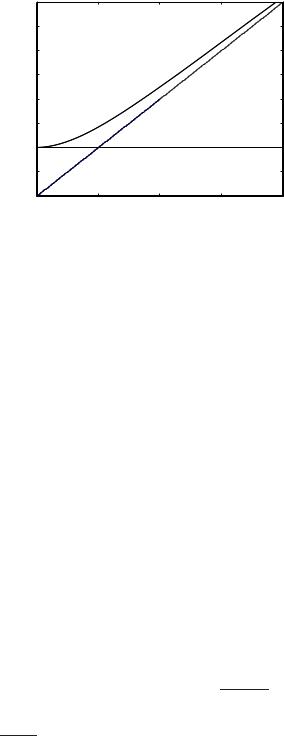
78 Plasmon–polaritons
Fig. 3.1 Dispersion of bulk plasmon– polaritons, of plasmons and of the electromagnetic wave in vacuum
|
4 |
|
|
|
|
|
3.5 |
|
|
|
|
|
3 |
|
|
|
|
|
2.5 |
|
|
light line |
|
|
bulk |
|
Z/k=c |
|
|
p |
|
|
|
||
2 |
plasmon− |
|
|
|
|
Z/Z |
|
|
|
||
|
polariton |
|
|
|
|
|
|
|
|
|
|
|
1.5 |
|
|
|
|
|
1 |
|
|
plasmon |
|
|
|
|
|
|
|
|
0.5 |
|
|
Z=Zp |
|
|
0 |
1 |
2 |
3 |
4 |
|
0 |
||||
|
|
|
k/kp |
|
|
5There is a stop band for ω < ωp. Note a general feature (Tilley, 1988) that surface modes can be found within the bulk mode stop bands. It is in this range that our other type of plasmon– polariton, the SPP, can propagate.
It is plotted in Fig. 3.1 as a function of k/kp (where kp = ωp/c), together with the ‘light line’ k = ω/c of the electromagnetic wave in vacuum and with the horizontal dispersion line ω = ωp.
The dispersion curve in Fig. 3.1 may be seen as resulting from the crossing of the bulk plasmon line ω = ωp and the light line k = ω/c. A possible way of interpreting the dispersion equation (3.6) is that there is no longer a pure electromagnetic and a pure plasma wave. Instead, the plasma wave interacts strongly with light, resulting in our bulk plasmon– polariton. The asymptotic and limiting cases for the dispersion are
ω → ωp |
as |
k → 0 . |
(3.7) |
ω → kc |
as |
k → ∞ |
|
At high frequencies the bulk mode lies close to the light line and is lightlike; at low wave numbers it moves away from the light line until the cut- o plasma frequency is reached. Bulk plasmon–polaritons of frequency below the plasma frequency cannot propagate5 in plasma because its free electrons screen the electric field of the light. Bulk plasmon–polaritons of frequency above the plasma frequency can propagate through plasma because the electrons cannot respond fast enough to screen it.
Since many of the properties of plasmon–polaritons are similar to those of phonon–polaritons it may be worthwhile to include here a brief note on the latter. The interaction is then between the electromagnetic wave and the optical branch (optical phonons) of the acoustic wave in an ionic crystal. There, the dielectric function has a form
6Note that ε0 in eqn (3.8) is not the free-space permittivity but the value of the dielectric constant at ω = 0.
εph = ε∞ + |
ωT2 |
(ε0 |
− |
ε∞) = ε∞ |
1 + |
ωL2 |
− ωT2 |
, |
(3.8) |
|
ωT2 − ω2 |
ωT2 − ω2 |
|||||||||
|
|
|
|
|
|
|||||
with ωT the so-called TO (transverse optical) phonon frequency and ωL = ωT ε0/ε∞ the LO (longitudinal optical) phonon frequency (see, e.g., Kittel 1963).6 The asymptotic and limiting cases here are
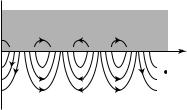
|
|
|
3.3 |
Surface plasmon–polaritons. Semi-infinite case, TM polarization |
79 |
|||||||||
|
|
εph → ±∞ |
as |
|
ω |
→ |
ωT |
|
|
|
|
|||
|
εph(ωL) = 0 |
|
|
|
|
. |
(3.9) |
|
|
|||||
|
|
εph → ε∞ |
as |
ω → ∞ |
|
|
|
|
||||||
|
equation is then k = ω |
ε |
|
μ. The frequency at which |
|
|
||||||||
The dispersion |
|
|
|
√ |
ph |
|
|
|
|
|
|
|
||
k = 0 is known as the Reststrahl frequency (Fox, 2001). Note further |
|
|
||||||||||||
that in the frequency range ωT < ω < ωL the dielectric constant is |
|
|
||||||||||||
negative7 and the wave vector is imaginary, meaning a stop band for |
7An example is SiC, a polar material. |
|||||||||||||
the bulk phonon–polariton. It may be instructive to note that formally |
It was used for subwavelength imaging |
|||||||||||||
the plasmon–polariton dispersion equation (3.5) is a special case of the |
in the negative dielectric constant |
re- |
||||||||||||
gion (see Section 5.4.6) by Korobkin |
||||||||||||||
phonon–polariton dispersion equation with ε∞ = 1, ωL = ωp and ωT = |
||||||||||||||
et al. 2006a; Korobkin et al. 2006b. |
|
|||||||||||||
0. |
|
|
|
|
|
|
|
|
|
|
|
|
|
|
3.3Surface plasmon–polaritons. Semi-infinite case, TM polarization
The electromagnetic field of SPPs at a dielectric–metal interface is obtained from the solution of Maxwell’s equations in each medium, and the associated boundary conditions. The latter express the continuity of the tangential components of the electric and magnetic fields across the interface. A further obvious condition is that the fields must decline away from the boundary and vanish infinitely far away.
3.3.1Dispersion. Surface plasmon wavelength
We consider now a plane interface z = 0 between two semi-infinite media, the first one being vacuum, air or a dielectric with the permittivity, ε1, taken here as frequency-independent; the second one being a metal with the permittivity, ε2, described by the Drude model (eqn (3.2)). We shall first look at the case of TM polarization. Recalling the results from Section 1.10 the conditions for the existence of a surface mode propagating along the surface in the x direction8 are given as
ε1ε2 < 0 and ε1 + ε2 < 0 . |
(3.10) |
The first of these conditions, requiring that the dielectric constant is changing sign at the boundary, has a simple meaning (Barnes, 2006). A surface mode involves charges accumulated at the boundary between the metal and the dielectric. The corresponding electric field that is built up would originate on positive charges and terminate on negative charges and do so, in fact, in both medium 1 and medium 2. This is shown schematically in Fig. 3.2. That means that in the presence of surface charges the components of the electric field normal to the surface must have opposite signs.
A boundary condition for the normal component of the displacement field is9
ε1E1z = ε2E2z , |
(3.11) |
 z
z
Metal E
+ + + |
+ + + |
x |
|
H
Dielectric
Fig. 3.2 SPP mode. A sketch of charge and electric-field distributions at the metal–dielectric boundary
8 For εr1 + εr2 < 0, μr1 = μr2 = 1 a TM surface mode with components Ex , Ez and Hy and propagating in the x direction is the only option. Explicit calculations show that there is no propagation for this mode in the y direction, nor is there a surface TE mode carrying Hx , Hz and Ey components.
9We have just described the role of surface charges and yet, when it comes to the boundary conditions, we ignore the surface charge. This apparent contradiction is resolved in Appendix D.

80 Plasmon–polaritons
10The positive sign in eqn (3.15) also has physical meaning and yields the Brewster wave discussed in Appendix E.
which is another way of saying that for a surface mode to exist dielectric constants in the two media must have di erent signs. The second condition of eqn (3.10) follows from eqn (1.73), which is given below
|
|
εr1εr2 |
|
kx = k0 |
εr1 + εr2 . |
(3.12) |
It ensures that kx is real so that the mode can propagate along the surface. It is a rather innocent-looking equation but it contains a large amount of information about the properties of SPPs at a single interface. Since εr2 is a function of frequency, eqn (3.12) is the dispersion equation, i.e. it provides the relationship between the frequency and the wave number. Inserting eqn (3.2) from the lossless Drude model into eqn (3.12) we find
where |
kx2 (1 + εr1)k02 − kp2 |
= k02 |
εr1(k02 − kp2) , |
(3.13) |
|||
|
kp = |
ωp |
= |
2π |
. |
(3.14) |
|
|
|
|
|
||||
|
|
c |
|
λp |
|
|
|
Equation (3.13) may then be solved for k0 to obtain the dispersion equation in terms of ω. It looks rather complicated so we shall give here the solution only for εr1 = 1
ω2 |
|
ωp2 |
+ c2kx2 ± |
ωp4 |
|
|
= |
|
|
+ c4kx4 , |
(3.15) |
||
2 |
4 |
|||||
which is not too long. Taking the negative sign10 we shall plot in Figs. 3.3(a) and (b) the dispersion curves at an interface metal–vacuum (εr1 = 1) and metal–glass (εr1 = 2.25).
The dispersion curve shows that at low frequencies the surface mode lies close to the light line and is light-like. As frequency increases, the mode moves away from the light line, gradually approaching an asymptotic limit. This occurs when the permittivities in the two media are of the same magnitude but opposite sign, thus producing a pole in the
dispersion equation (3.12) (Barnes, 2006). The asymptotes are |
|
|||||||||
kx → ∞ |
|
|
as |
ω → ωs |
|
|
||||
k |
ω √ |
ε |
|
|
as |
ω |
→ |
0 |
, |
(3.16) |
|
x → c |
r1 |
|
|
|
|
||||
where |
|
|
|
|
|
|
|
|
|
|
|
ωs = |
√ |
ωp |
|
|
|
|
(3.17) |
||
|
|
|
|
|
|
|||||
|
1 + εr1 |
|
|
|
||||||
|
|
|
|
|
|
|
|
|
||
is the upper cuto frequency for the surface mode. For vacuum it is
ωp |
|
ωs = √2 . |
(3.18) |
Medium 2 with negative permittivity is often called the surface-active medium, while medium 1 with positive permittivity is called the surfacepassive medium. The reason is quite simple. The terms express the fact
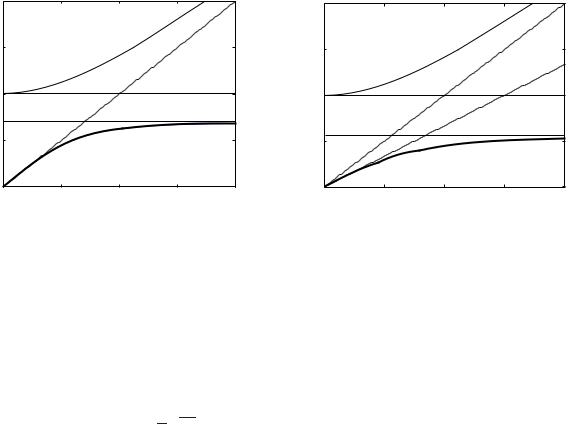
3.3 Surface plasmon–polaritons. Semi-infinite case, TM polarization 81
|
2 |
|
|
|
|
|
1.5 |
bulk |
|
light line |
|
|
plasmon− |
|
Z |
|
|
|
|
polariton |
|
/k=c |
|
|
|
|
|
|
|
p |
1 |
|
|
Z=Zp |
|
Z/Z |
|
|
|
|
|
|
|
|
|
|
|
|
|
|
|
Z=Zs |
|
|
0.5 |
|
surface |
|
|
|
|
|
plasmon− |
|
|
|
|
|
polariton |
|
|
|
0 |
0.5 |
1 |
1.5 |
2 |
|
0 |
||||
|
|
|
k/kp |
|
|
|
|
|
(a) |
|
|
|
2 |
|
|
|
|
|
|
bulk |
|
|
Z/k=c |
|
1.5 |
|
|
|
|
|
plasmon- |
|
Z/k=c/H1/ 2 |
||
|
|
polariton |
|
||
|
|
|
|
r1 |
|
p |
1 |
|
Z=Zp |
|
|
Z/Z |
|
|
|
|
|
|
|
|
|
|
|
|
0.5 |
Z=Zs |
|
|
|
|
|
|
surface |
|
|
|
|
|
|
|
|
|
|
|
|
plasmon- |
|
|
0 |
|
|
polariton |
|
|
0.5 |
1 |
1.5 |
2 |
|
|
0 |
||||
|
|
|
k/kp |
|
|
|
|
|
(b) |
|
|
Fig. 3.3 Dispersion of SPPs (solid line) at the boundary vacuum–metal (a) and at the boundary glass–metal (b). Also shown is the dispersion curve of the bulk mode with ky = kz = 0 (thin solid line), the light line in vacuum and in the dielectric (dashed lines), the dispersions of bulk (dotted line) and surface plasmons (dashed-dotted line)
that it is charges in medium 2 that lead to electric-field oscillations at the boundary (Abeles, 1986; Tilley, 1988).
Note that the SPP dispersion lies in a region to the right of the light lines in medium 1, where the kx values are larger than the wave number of the propagating electromagnetic wave
ω √
kx > c εr1 , (3.19)
and therefore this mode is non-radiative, or bound (Burke et al., 1986). This means that this wave has no propagating component in the z direction; z components of the k vector are purely imaginary. There are two important consequences. First, the surface mode on such a flat interface cannot decay by emitting a photon, and, conversely, it cannot be excited directly by an incident plane wave. An incident plane wave can never have a wave vector parallel to the interface large enough to couple to this surface mode. In order to couple to the SPP, both k and ω must match. In engineering terms one could say that both frequency and velocity must agree, whereas physicists would talk about conservation of energy and momentum. One may use a prism-coupling scheme based on the method of attenuated total reflection, which would provide an evanescent component with imaginary kz and su ciently large kx. Best known are the Kretschmann and the Otto configurations (Kretschmann and Raether, 1968; Otto, 1968). Another consequence is that this mode is capable of interacting with the evanescent part of a spectrum from a small subwavelength object, providing an important mechanism for subwavelength imaging lying at the heart of the concept of the ‘perfect lens’ (see Chapter 5 for a detailed analysis).
According to the inequality (3.19) the SPP wavelength is always smaller
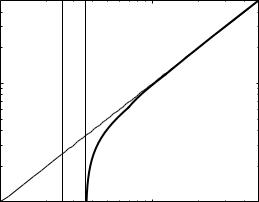
82 Plasmon–polaritons
Fig. 3.4 Dispersion curve for the metal–vacuum interface
[m] |
|
|
|
|
|
SPP |
|
|
|
|
|
λ |
|
|
|
|
|
wavelength |
10−6 |
|
|
|
|
|
|
|
|
|
|
polariton |
light |
|
|
|
|
line |
|
|
|
|
|
|
|
|
|
|
|
|
10−7 |
|
|
|
10−6 |
|
10−7 |
λ |
λ |
s |
|
|
|
p |
|
|
|
|
|
free space wavelength λ [m] |
|||
11A technique often used (see, e.g., Gray and Kupka 2003).
than the free-space wavelength. It would be desirable at this stage to abandon the normalized quantities ω/ωp and k/kp and find the actual values of the various characteristics of the waves, starting with the plasma frequency. For silver, the value of the plasma frequency was determined experimentally by McAlister and Stern (1963) from the dip in the transmission of electromagnetic waves through a thin film. They measured the plasma frequency in terms of electron volt units, giving a value of 3.8 eV, which in SI units corresponds to 918 THz or a wavelength of 326 nm. According to Pendry (2000) the plasma frequency is approximately 9 eV, corresponding to 2183 THz, a big di erence. The main problem is of course that the Drude model, assumed so far is not valid for frequencies close to the plasma frequency. When ω = ωp the dielectric constant is not equal to 1 but to a value of ε0 (a horrendous deviation from the meaning of ε0 in the SI system) due to interband transitions. If we follow Pendry and take its value as 5.7 then εr is equal to −1 at a wavelength of 359 nm. When coming to imaging by a silver lens then this is the wavelength range at which successful imaging was obtained (see, e.g., Melville and Blaikie 2005). Can we save the Drude model without contradicting experimental results? We can do it by choosing the plasma frequency so that the Drude relation remains approximately true11 in the critical region around εr = −1. This choice led us to fp = 1200 THz. We can now plot (Fig. 3.4) the wavelength of the SPP mode λSPP = 2π/kx versus free-space wavelength λ = 2πc/ω. As the free space wavelength approaches the asymptotic value λs = 2πc/ωs the SPP wavelength becomes much shorter than the free-space wavelength, opening up the possibility for subwavelength manipulation of the fields. For larger values of the free-space wavelength, λSPP is only marginally smaller than λ.
In view of the dispersion equations derived we should say here a few more words about terminology. The logical thing would be to call the waves surface plasmon–polaritons for small kx when the dispersion curve is close to that of electromagnetic waves in free space and it is some kind
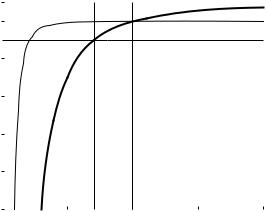
permittivity H’, − H"
3.3Surface plasmon–polaritons. Semi-infinite case, TM polarization 83
1 |
|
Zs |
Zp |
|
|
|
|
|
|
|
|
|
|||
0 |
|
|
|
|
|
|
|
|
|
|
|
|
|
|
|
−2 |
|
−H" |
|
|
|
|
|
|
|
|
|
|
|
|
|
−4 |
|
H’ |
|
|
|
|
|
|
|
|
|
|
|
|
|
−6 |
|
|
|
|
|
|
|
−8 |
|
|
|
|
|
|
|
−20 |
|
|
|
|
|
|
Fig. 3.5 The real and imaginary parts |
|
|
|
|
|
|
of the dielectric function for a lossy |
|
|
0.5 |
1 |
1.5 |
2 |
|||
0 |
|||||||
Z/Zp |
metal according to the Drude model |
|
(γp /ωp = 0.01) |
||
|
of hybrid wave, but call them surface plasma waves for large kx. Alas, logic is not an influential factor when it comes to terminology. We shall accept the majority view, accept the term surface plasmon–polariton, and keep on referring to them as SPPs. This may also be the place where we can mention the electrostatic limit, which means obtaining the dispersion equation by solving Laplace’s equation instead of the full apparatus of Maxwell’s equations. This is permissible for large kx. For more details see Appendix F.
3.3.2E ect of losses. Propagation length
If we take losses of medium 2 into account, we should expect that a surface wave bound to the interface would propagate along the surface a finite distance, until its energy is dissipated as heat in the metal.
In eqn (3.12), in the presence of losses, the right-hand side is a complex quantity, and so is the left-hand side, meaning that kx will have an imaginary part as well. We need to write
kx = kx − j kx , |
(3.20) |
and the complex relative permittivity of the metal as
εr2 = ε − j ε . |
(3.21) |
We obtain for its real and imaginary parts (Boardman, 1982; Berini, 2000a)
ε = 1 − |
ωp2 |
ε = |
ωp2γp |
|
||
|
, |
|
. |
(3.22) |
||
ω2 + γp2 |
ω ω2 + γp2 |
|||||
The corresponding values of kx and kx may be determined from eqn (3.12) by substituting into it the complex value of the dielectric

84 |
Plasmon–polaritons |
|
|
|
|
|
0.7 |
|
|
|
|
|
0.6 |
|
|
|
|
|
0.5 |
|
|
|
Re(k x) |
|
|
|
|
Im(kx) |
|
|
|
|
|
|
|
p |
0.4 |
|
|
|
light line |
|
|
|
Z=Zs |
||
Z/Z |
0.3 |
|
|
|
|
|
|
|
|
|
|
|
0 2 |
|
|
|
|
|
0.1 |
|
|
|
|
|
0 |
0.5 |
1 |
1.5 |
2 |
|
0 |
||||
kx/kp
(a)
|
0.7 |
|
|
|
|
|
0.6 |
|
|
|
|
|
0.5 |
|
|
|
Re(k x) |
|
|
|
|
Im(kx) |
|
|
|
|
|
|
|
p |
0.4 |
|
|
|
light line |
Z/Z |
0.3 |
|
|
|
Z=Zs |
|
|
|
|
|
|
|
0.2 |
|
|
|
|
|
0.1 |
|
|
|
|
|
0 |
0.5 |
1 |
1.5 |
2 |
|
0 |
kx/kp
(b)
Fig. 3.6 Dispersion for lossy metal. γp/ωp = 0.01 (a) and 0.1 (b)
constant. The real and imaginary parts of εr2 are plotted in Fig. 3.5 as a function of frequency for γp = 0.01ωp.
The dispersion curves in the presence of losses may now be calculated with the aid of eqn (3.12). They are plotted in Figs. 3.6(a) and (b). The normalized horizontal co-ordinate is kxc/ωp = kx/kp for the propagation coe cient (solid lines) and kxc/ωp for the attenuation. For the lossless case γp = 0 there is no attenuation in the pass band between 0 and ωs. For γp/ωp = 0.01 the attenuation becomes significant just below ωs but it declines sharply as the frequency decreases (Fig. 3.6(a)). The same is true for γp/ωp = 0.1 but the e ect is more substantial (see Fig. 3.6(b)). All the information about propagation and attenuation is properly contained in Figs. 3.6(a) and (b) but this is not the way most people in the art of plasmas like to talk about attenuation. They prefer to use the measure of propagation length, the distance the SPP travels before its intensity is reduced by a factor of e. The relationship between the propagation length and the attenuation coe cient is LSPP
(the factor 2 is there because propagation length refers to intensity, whereas we have used kx for the attenuation of the wave amplitude). For this reason we also plot the propagation length in Fig. 3.7 for the same set of loss parameters. It may be seen that in the visible region (with our choice of ωp) it falls roughly between 0.2ωp and 0.4ωp. The largest value of the propagation length for γp = 0.01 ωp is about 10 μm, a very small length. On the other hand, it is still large relative to both the free-space wavelength and the SPP wavelength. So there would be about 20 wavelengths available for manipulation of information and that might be enough for practical application.
